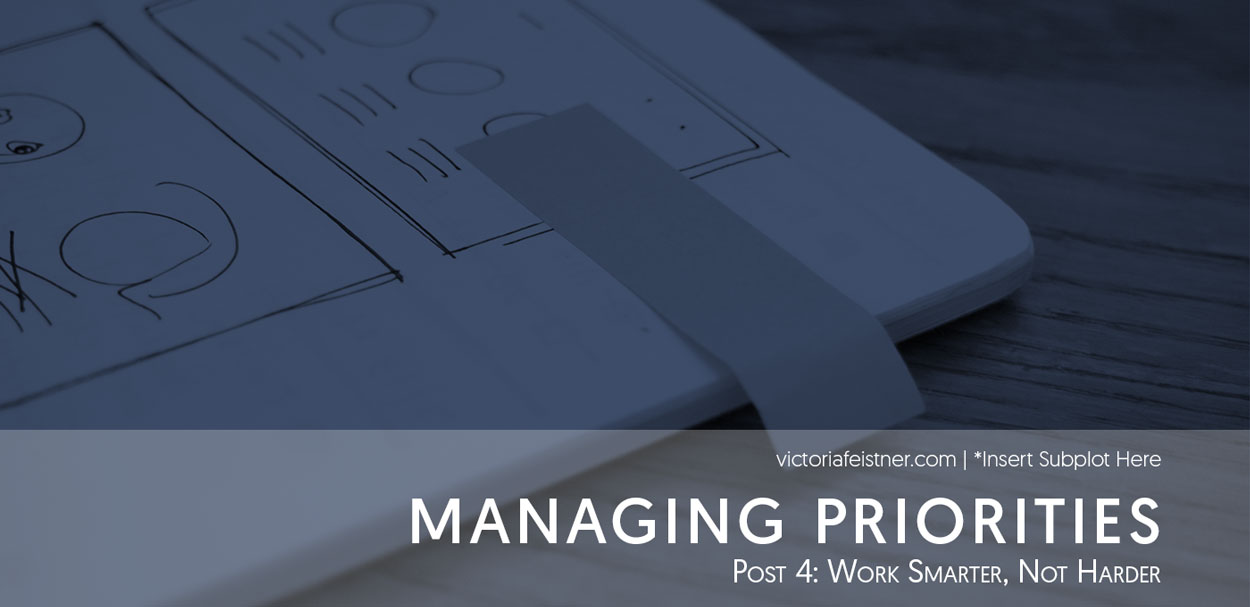This is Part 4 of the Managing Priorities Series. The other parts can be found here: #1, #2, #3, #5
Work Smarter, Not Harder
Last week we looked at how to figure out what your laziest block of time is–aka a “Unit”–and hopefully you’ve been keeping track of your energy levels through the day. Even over a week patterns should become apparent but if not, feel free to keep track for another week or even a month. The more data points you have the more reliable the information. Science! Today we’re going to be covering how to tie those data points into your projects.
 Tricking Your Brain 101
Tricking Your Brain 101
Many people have said that a page a day is a novel in a year, and that’s the principle behind NaNoWriMo. A novel is this monolithic THING that is a massive challenge only undertaken by wizards or people with too much time on their hands, but given a framework of small daily work it becomes manageable. I love writing; NaNoWriMo is my favourite time of year, more than Christmas. But if I’m not feeling well or didn’t sleep, even I struggle to get my ass in the writing chair. That’s where reframing comes in: NaNo goes from “write 1667 words a day”–a task I can do in about 2 hours–into “write 4 units”. Doesn’t seem like a big difference, but it’s much easier to find four chunks of 15 minutes than it is to find two continuous hours, and that’s often the difference between the Week 2 Weepies and crossing the finish line on the 30th.
But the biggest advantage to thinking in Units isn’t scheduling: it’s about beating procrastination.
For instance: if you come home and there is a huge sink of dirty dishes that need washing, it’s tempting to leave them until after dinner (even though then there will be more of them and you will be full and sleepy). Because it’s not about the actual task, but rather the perceived unpleasantness combined with the knowledge that it will take forever to complete because washing dishes is the worst.
Dirty dishes on one hand, a phone with FB on the other. It’s easy to say “I’ll do it later” and then “later” becomes two hours in the Dark Playground. We know this pattern well.
Instead, use the inherent laziness of your Unit. “I’ll just wash dishes for 15 minutes. 15 minutes is nothing.”
Often, that’s enough to break the cycle, because the problem was not the task itself but just getting over the hump and starting. But–and this is important–brains figure shit like this out if you lie to them too often. So to trick them you need to build in the stipulation that after the Unit is over you will stop. And then you have to do it. It’s a contract that you need to reinforce for it to really, truly, sink in. So if you’re washing dishes with one eye on the clock, stop after your Unit is up. Or set a timer and then stop. With something small like dishes 15 minutes is probably enough to wash them all anyway, but if it’s not… leave the remaining ones. Walk away or choose to set another timer. But honour the contract.
Why bother? Because it’s very easy to beat ourselves up for not doing what we’re “supposed” to be doing in the “right” amount of time according to what we think other people are capable of. But rarely does that beratement improve results; most often it simply contributes to a shame spiral that leads to, oh yes, the Dark Playground. The dishes stay unwashed. And so the circle continues.
A Note on Depression
I’ve talked about my depression in the blog before. I’ve had days where the only thing that dragged me out of bed was the bathroom. I have been there; I understand. And these are the tricks that I taught to myself to get things done even when getting dressed in the morning was an overwhelming challenge. But all that to say:
Please be kind to yourself. If you’re struggling with depression, the last thing that you need is over ambitious goals that you can’t fulfill that just turn into another reason to feel down on yourself. If you can’t finish the dishes in 15 minutes, then walk away. You did 15 minutes of dish-washing! If that is your limit, then that is your limit and that’s okay. It took me a long time and a lot of shame spirals before I realized that the person hardest on me was: me. Instead of beating myself up for not having the same amount of energy as “everyone else” I made the decision to start ‘hacking’ my habits instead, and figuring out the easiest, simplest way to get things done, and to walk away when I needed to.
It was only later that I discovered other people have come to the same conclusions independently. So I’ll link to those ideas and research as well. But everything I recommend has been born out of my own experience.
Maybe 9 to 5 Isn’t For You
The single biggest lifehack I made was to restructure my day around my energy levels instead of forcing my energy to conform to my schedule. I used to spend my mornings catching up on emails and then be struggling to do work in the afternoon when my brain was asleep. I’d goof around until about 5 then finally break for dinner. I’d do a bit more work in the evening but I’d be angry with myself for not completing what I set out to do in a more timely manner so I’d go to bed fretting and gnashing my teeth over unfinished tasks piling up around me. Sound familiar?
Post-hacking, I do my creative/high priority tasks first, being a morning person. When I get to the ‘need to move around’ stage (around 11am) I do chores and tidying. I have lunch, and I do emails or admin work from 1-3pm because they’d don’t require creative problem-solving, just a pomodoro or two of focus. Then I run my errands. By 5pm I’m ready to start dinner and I’ve generally accomplished what I set out to do. Knowing that I only have 2-3 hours of peak focus in the morning helps me shape the scope of my tasks. If I need to, I can finish work in the evening, but more often than not I go for a walk in the evening, or just relax and watch TV, or read, or craft. Actual relaxation, not procrastination. I turn my phone off an hour before bed and read. I wake up ready to work.
Spending my morning doing emails was the biggest waste of time because I spent precious creative energy on low-creativity tasks and then goofed off instead of buckling down in the afternoon. But I wouldn’t have made the connection without the raw data.
Two-Minutes to Happiness
The Two Minute Rule is simply that if something takes under 2 minutes to do, do it now, not later. We all know the feeling of wanting to start one task only to delay beginning while we take care of chores that didn’t get done earlier (like when you want to work on the kitchen table but it’s covered in clutter that you dumped there instead of putting it away). It sucks, and invites procrastination. I often say to myself ‘is this less than 2 minutes?’ when considering a short-cut (like not hanging my coat up, I am definitely a life-long coat draper). It sounds ridiculous, but it works.
Additionally, when you complete a small task, you get a little hit of dopamine, which you might recognize as the small thrill that comes from crossing an item off a to-do list.
Dopamine also helps motivate us into further actions, which is why we often feel ‘on a roll’ after completing a few smaller tasks in a row. Hmm. Where did we have a list of smaller tasks that we could complete? Oh, hello, our KISS list from two weeks ago! By getting a few smaller tasks out of the way right at the beginning we can prime ourselves with delicious, delicious dopamine and use it to keep us going. This is also why it pays to break down larger tasks and write them down as a series of small ones: because dopamine is great.
Tomatoes
Even though I arrived at my idea of Units independently, I still often refer to them as tomatoes (in my tasks list I often draw little tomatoes that I colour in after I complete each Unit). The Pomodoro Technique is powerful and well-researched. You set a timer and work on that one task—no interruptions allowed—until the timer goes off, at which point you get a short break to go to the bathroom or answer emails or whatever. Repeat as needed. It’s the first thing I recommend to people who have trouble focusing. The traditional length of a pomodoro is 25 minutes with a 5 minute break; I use 15 minutes instead, since that’s easier to convince myself to do (I am super lazy and I don’t wannaaaa). But the technique is the same. Set a timer, focus. Break. Repeat. (Drawing out and colouring in the tomatoes is just a fun treat for me.) Try the 25 minute ‘standard’ a few times over a few days and then adjust as needed. As always, what works for you is what works and everyone is different.
Now for the hard part.
Put your phone in another room.
At least to start. “What!” I hear you shriek. “Then how will I time myself/listen to music/hear it ring…”
Find a timer (the pomodoro guy used an oven timer in the shape of a tomato; hence the name). Listen to the radio. Put a CD on. Let it go to voicemail.
I’m serious here. When you’re first starting out, before you build up that habit, your phone is a powerful, powerful draw. It was literally designed to be as addictive as possible. Remember how we talked about dopamine hits and how to use them to complete tasks? Yeah well the people who design apps like FB know all about that too. And if you’ve gotten this far in the series, you need to give yourself all the help you can get.
PUT. YOUR. PHONE. IN. ANOTHER. ROOM.
Turn your computer’s wifi off. Lock the door. Tell your family/coworkers to leave you alone. Put on big ear-can headphones. DO WHATEVER IT TAKES. Because otherwise you will break your concentration to check your notifications or to answer a question and then you’ll feel like the pomodoro method doesn’t work and this is stupid and everything is the worst and life is toilets.
This is Tough Love time: your phone will not help you focus. Treat it like an enemy hostile. You’re only stepping away from it for, at most, 25 minutes. You can check messages on your break. “But…!”
NO BUTS. NO PHONE.
When I need to really get crackin’ I institute ‘no wifi mornings’ and turn off my phone and airplane my laptop until lunch. It’s hard some days to stick to but it’s made a huge difference in how much I can complete on a given day.
Friendly Competition
The last tip I have only works for certain types of people, but if you’re one of them it can be pretty powerful. Perhaps you’ve heard of Strava? It’s a bike app that tracks your times and routes and then compares them to other people in your neighbourhood. Or maybe you’ve done Word Sprints for NaNo, where you and others write furiously for the same amount of time and see who has the highest word count. (If you want to do that, hit me up on Twitter, I am usually game for it.)
If you’re even slightly competitive–even with yourself–it can become very effective to monitor your progress in a chart or app, especially when you compare it to your energy levels. It becomes a kind of game. Often just the knowledge that other people are out-performing me is what spurs me on; I suspect that this effect is why some people prefer to work in cafes where other people are working. I know for me that when I start to drift off-task, looking around at the other people with their headphones in reminds me to keep going. I certainly know that I am more productive at certain tasks with other people around (such as editing) whereas other tasks (such as writing) I am better when I am by myself. (Science! I have charts.) Either way, if you think it might help, then by all means start experimenting with gamifying your tasks. But if you think that it might make you stressed out to compare your rate with other people, then honour that feeling. Whatever works for you, is what works.
Next week is the last in the Managing Priorities: we’re going to discuss the where of your project, and how that might influence you, and how to make it as easy to start work as possible.
The Complete Managing Priorities Series:
Project Managing Yourself | Decluttering Your To-Do List | Time Units and Science! | Work Smarter, Not Harder | Location, Location, Location


One Comment for "Managing Priorities Post #4: Work Smarter, Not Harder"